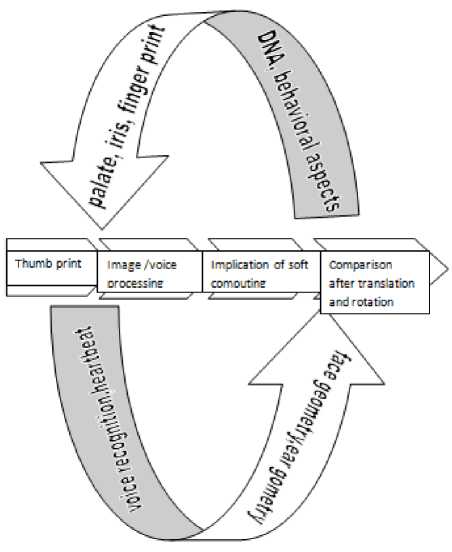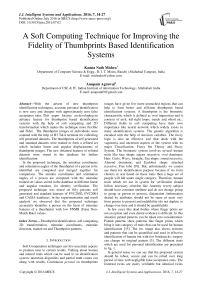A Soft Computing Technique for Improving the Fidelity of Thumbprints Based Identification Systems
Автор: Kamta Nath Mishra, Anupam Agrawal
Журнал: International Journal of Intelligent Systems and Applications(IJISA) @ijisa
Статья в выпуске: 7 vol.8, 2016 года.
Бесплатный доступ
With the advent of new thumbprint identification techniques, accurate personal identification is now easy and cheaper with approximately zero false acceptance rates. This paper focuses on developing an advance feature for thumbprint based identification systems with the help of soft computing and 2D transformation which makes the technique more flexible and Fidel. The thumbprint images of individuals were scanned with the help of H3 T&A terminal for collecting self generated datasets. The thumbprints of self generated and standard datasets were trained to form a refined set which includes linear and angular displacements of thumbprint images. The new obtained features of refined datasets were stored in the database for further identification. In the proposed technique, the minutiae coordinates and orientation angles of the thumbprint of a person to be identified are computed and merged together for comparison. The minutia coordinates and orientation angles of a person are compared with the minutiae trained set values stored in the database at different linear and angular rotations for identity verification. The proposed technique was tested on fifty persons self generated and standard datasets of FVC2002, FVC2004 and CASIA databases. In the experimentation and result analysis we observed that the proposed technique accurately identifies a person on the basis of minutiae features of a thumbprint with low FNMR (False Non-Match Rate) values.
Thumbprint identification, soft computing, 2D transformation, minutiae coordinates, minutiae direction, trained set and Thumbprint patterns
Короткий адрес: https://sciup.org/15010836
IDR: 15010836
Текст научной статьи A Soft Computing Technique for Improving the Fidelity of Thumbprints Based Identification Systems
Published Online July 2016 in MECS
Soft Computation techniques use few uncertain aspects to produce near to certain results. Talking about human and natural traits which can be used in an identification system, uncertain disparities and partial truth comes out along with results. Continuous perusal on thumbprints images have given few more untouched regions that can help to form better and efficient thumbprint based identification systems. A thumbprint is the biometric characteristic which is defined as oval impression and it consists of arch, left-right loops, trench and whorl etc.. Different fields in soft computing have their own importance like neural network which widely exists in many identification systems. The genetic algorithm is encoded with the help of decision variables. The fuzzy logic is also an effective tool that deals with the vagueness and uncertain aspects of the system with its major Classification: Fuzzy Set Theory and Fuzzy System. The biometric system involves several human traits like face shape; square recessive; oval dominant; Hair: Curly, Wavy, Straight; Eye shape: round recessive, Almond dominant; and Earlobes shape: attached recessive, Free lobe [10]. But, unfortunately we cannot use them for identification purpose because if we form clusters or sets based on these traits then a huge set of people will fall under single category. Therefore, human traits which we use in system for verification should follow necessary criterion like Amenity (every subject should have common attribute and do not change group to group or person to person), disjunction (information shared by attributes should not be same or must vary from person to person) and indelibility (do not deplete or change over time and it should be quantifiable)
In few cases like dead bodies where finger prints are not an option and even dental evidence is difficult. In this situation palatal patterns can be taken into consideration. Palatal patterns show patterns like finger prints which bring it into category of traits that can be used for human identification [33]. The iris image also shows textures and patterns that can be quantified and used in effective identification of human but with few bottlenecks: surgery can change its original pattern [3]. The different traits which are used for personal identification are presented in fig. 1.
In general sense we can say that the proposed system should be robust, secure and can be relied over long period of time with negligible false acceptance rates. The fraternal twins are easily verifiable but identical twins identification is a challenging task. With increasing twin ratio every year we need to upgrade existing systems [11].

Fig.1. Identification system using different traits for personal identification.
In this paper we proposed a new refined technique that will help our existing thumbprint based identification systems to identify individual more accurately and it will also work for identical twins identification. The proposed technique of this paper is the extension of existing thumbprint based biometric identification systems which are effective in terms of space and efficient in terms of time with improved fidelity. In this paper soft computing technique along with 2D transformation is proposed to discover a better and flexible identification system.
In the next section (section 2) we have discussed literature review of existing systems. The section 3 describes mathematical model of the proposed system. In section 4 we have proposed new algorithms and model which uses soft computing techniques for improving the fidelity of thumbprint based systems. The section 5 analyses the performance of proposed system and the results of proposed algorithm is compared with other techniques in this section. The section 6 concludes the outcomes of this paper.
-
II. Literature Review
Список литературы A Soft Computing Technique for Improving the Fidelity of Thumbprints Based Identification Systems
- Aldridge S, ”Image Sets For The Training Of Image Processing”, GECCO '10 Proceedings of the 12th annual conference companion on Genetic and evolutionary computation , p. 2039-2042, 2010.
- Amayeh G, Bebis G, Erol A, and Mircea Nicolescu “Hand-based verification and identification using palm–finger segmentation and fusion”, Computer Vision and Image Understanding, Vol. 113, No. 4, 477–501, 2009.
- Arora S.S, Vatsa M, Singh R, and Jain A, "Iris recognition under alcohol influence" Biometric(ICB), 5th IEEE IAPR International Conference on Biometrics Compendium, p. 336–341, 2012.
- Barkhoda W, Tab F. A, and Amiri M. D,” Rotation Invariant Retina Identification Based On The Sketch Of Vessels Using Angular Partitioning”, IEEE International Multi-conference on Computer Science and Information Technology, p. 3 – 6, 2009.
- Candamo J, Shreve M, Dmitry B. Goldgof Deborah B. Sapper, and Kasturi R, “Understanding Transit Scenes: A Survey on Human Behavior-Recognition Algorithms”, IEEE Transactions on Intelligent Transportation Systems, Vol. 11, No. 1, 2010.
- Chain T. P, Yau Wei-Yun, and Jiang X, “Token-Based Fingerprint Authentication”, Recent Patents on Computer Science, Vol. 2, p. 50-58, 2009.
- Danese, M. Giachero, Leporati F., and Nazzicari N., “An embedded multi-core biometric identification system 3 G”. 13TH European Conference on Digital System Design: Architectures, Methods and Tools (DSD), p. 779 – 784, 2010.
- Delac K., Grgic M., and Grgic S., “Face recognition in JPEG and JPEG2000 compressed domain”, Image and Vision Computing ,Vol. 27, No. 8, p. 1108-1120, 2009.
- Han Y, Ryu C, Moon J, Kim H, and Choi H., “A study on evaluating the uniqueness of fingerprints using statistical analysis”, Information Security and Cryptology – ICISC04, p. 467 – 477, 2004.
- Human Traits: Autosomal, http://faculty.southwest.tn.edu/jiwilliams/Human_Traits.htm, last seen 1/17/2014
- Indi S.T., and Raut D.S., “Biometric Feature Based Person Unique Identification System”, International Journal of Computer Application, Vol. 51, No. 13, p. 7-12, 2012.
- Jaimes A, and Sebe N., “Multimodal human–computer interaction: A survey”, Computer Vision and Image Understanding, Vol. 108, No. 2, p. 116-134, 2007.
- Jain A. K, Lin Hong, and Ruud Bolle, “On-Line Fingerprint Verification”, Proceedings of 13th International Conference on Pattern Recognition,, Vol. 3, p. 596 – 600, 1996.
- Jain A. K., Prabhakar S., and Pankanti S., “On the Similarity of identical twin fingerprint”, Pattern Recognition, Vol. 35, p. 2653-2663, 2002.
- Jain A. K., Feng J., “Latent Fingerprint Matching” IEEE Computer Society, Vol. 33, No. 1, p. 88-100, 2011.
- Josphineleela R., and Ramakrishnan M., “An Efficient Automatic Attendance System Using Fingerprint Reconstruction Technique”, International Journal of Computer Science and Information Security, Vol. 10, No. 3, p. 1-6, 2012.
- Kondekar M.H, Kulkarni U.V., and Krishna Kanth B.B.M., “Extended Fuzzy Hyperline Segment Neural Network for Fingerprint Recognition”, International Journal of Biometrics and Bioinformatics, Vol. 5, No. 3, p. 162-171, 2011.
- Kulkarni J.V., Patil B.D., and Holambe R.S., “Orientation Feature for fingerprint matching “, Pattern Recognition, Vol. 39, p. 1551-1554, 2006.
- Leung M., Engeler W., and Frank P. , “Fingerprint Image Processing Using Neural Network”, IEEE TENCON conference on Computer and Comm. System, p. 582-586, 1990.
- Mishra K. N., Srivastava P. C., Agrawal Anupam, Tripathi V., and Gupta V. “An Efficient Eigen Values Based Technique For Online Iris Image Compression and Identification” International Journal of Information Acquisition, Vol. 8, No. 2, 2011.
- Mishra K. N., Srivastava P. C., and Agrawal Anupam, “A Framework Towards Using Eigen Iris, Minutia Thumb and DNA Sequence Features For Personal Identification”, International Journal of Information Acquisition, Vol. 8, No. 3, p. 197-225, 2011.
- Mishra K. N., Srivastava P. C., Agrawal Anupam, Tripathi V., and Garg R., “Minutiae Distances and Orientation Fields Based Thumbprint Identification of Identical Twins”, International Journal of Image Graphics and Signal Processing, Vol. 5, No. 3, p. 51-59, 2013.
- Mishra K. N., Srivastava P. C., Agrawal Anupam, Garg R. and Singh A., “Minutiae Fusion Based Framework for Thumbprint Identification of Identical Twins”, International Journal of Intelligent system and application, Vol. Vol. 5, No. 2, p. 84-101, 2013.
- Patil D.S., and Patil S.A., “Fingerprint recognition using minutia matching”, World Journal of Science and Technology, Vol. 2, No. 4, p. 178-181, 2012.
- Phua K., Chen J., Dat T. H., “Heart sound as a biometric”, Pattern Recognition, Vol. 41, No. 3, p. 906-919, 2008.
- Ribaric S., Fratric I., “A Biometric Identification System Based on Eigenpalm and Eigenfinger Features’’, IEEE Transactions on Pattern Analysis and Machine Intelligence, Vol. 27, No. 11, 2005.
- Rodwella P. M., Furnella S.M., and Reynold P. L., “A non-intrusive biometric authentication mechanism utilizing physiological characteristics of the human head”, Computers & Security, Vol. 26, No. 7-8, p. 468-478, 2007.
- Saviˇc T., and Paveši´c N., “Personal recognition based on an image of the palmar surface of the hand”, Pattern Recognition, Vol. 40, No. 11, p. 3152-3163, 2007.
- Suutala J., and Ning J.R., “Methods for person identification on a pressure-sensitive floor: Experiments with multiple classifiers and reject option”, Information Fusion, Vol. 9, No. 1, p. 21-40, 2008.
- Sun Zhenan, Paulino A., Feng J., and Chai Z., “A Study of Multi-biometric Traits of Identical Twins”, Proc of SPIE, Biometric Technology for Human Identification, Vol. VII, p. 7667 -76727, 2010.
- Srihari Sargur N., Srinivasan H., and Fang G., “Discriminability of Fingerprints of Twins”, Journal of Forensic Identification, Vol. 58, No. 1, p. 109-127, 2008.
- Tao X., Chen X., Yang X., and Tian J., “Fingerprint Identification with Identical Twin Fingerprints”, PLoS One, Vol. 7, No. 4, e35704, (doi:10.1371/journal.pone.0035704), 2012.
- Thomas C. J., Van Wyk CWJ, “The palatal rugae in an identification”, Forensic Odontostomatol, Vol. 6, No. 1, p. 21-7, 1988.
- Zhang Y, and Martınez A. M., “A weighted probabilistic approach to face recognition from multiple images and video sequences”, Image and Vision Computing, Vol. 24, No. 6, p. 626-638, 2006.


